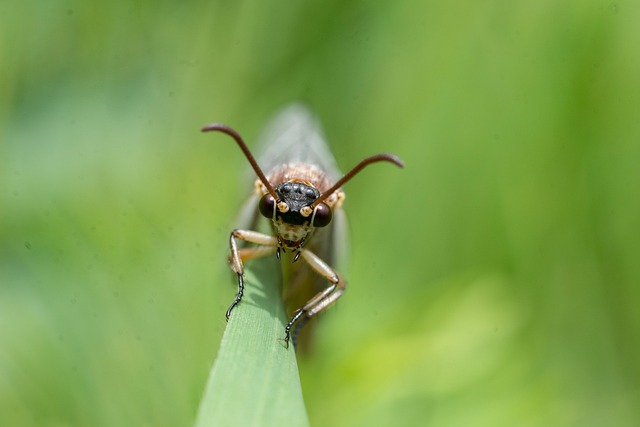Psocids, microscopic insects causing significant damage to materials and cultural heritage, require immediate action. Traditional chemical pesticides have drawbacks, prompting the need for advanced technologies like biological control agents, monitoring systems, heat treatments, and specialized cleaning products. Innovative solutions such as advanced imaging, sensors, robotics, AI apps, and nanotechnologies are transforming psocid infestation removal, offering safer, more effective, and environmentally friendly alternatives. These cutting-edge tools streamline treatment processes, enhance precision, and hold promise for even faster and sustainable control methods in the future.
Psocids, also known as book lice, are tiny insects that can cause significant distress in homes and commercial spaces. This article delves into the advanced technologies transforming the way we detect and treat psocid infestations. From traditional methods to innovative solutions, we explore efficient strategies for psocid infestation removal. Understanding these pests’ behavior and impact is crucial, as we navigate the landscape of modern pest control, leveraging technology to create a cleaner, more comfortable environment.
Understanding Psocids: Behavior and Impact
Psocids, also known as book lice or bark lice, are tiny insects that belong to the family Psocidae. Despite their name, they have no relation to lice. These microscopic creatures thrive in various environments, from libraries and museums to homes and agricultural settings. Understanding psocid behavior is crucial for effective infestation removal. They are highly adaptive and can quickly multiply, infesting a wide range of materials such as paper products, textiles, wood, and even crops. Psocids feed on these substances, causing damage that ranges from discoloration and weakening of materials to substantial financial losses in agricultural settings.
The impact of psocid infestations goes beyond material damages. In libraries and museums, for instance, they can devastate historical documents and artifacts, leading to irreversible loss of cultural heritage. Moreover, their presence can negatively affect indoor air quality due to the debris they produce, which can trigger allergies and respiratory issues in sensitive individuals. Recognizing these challenges underscores the importance of prompt action and advanced technologies in psocid infestation removal, ensuring a cleaner, healthier environment for living and working spaces.
Traditional Methods of Psocid Infestation Removal
Traditional methods for addressing psocid infestation removal have relied on a combination of chemical pesticides and physical barriers. Pesticides, such as pyrethroids and organophosphates, are often used to kill visible psocids and their eggs. However, these chemicals can have drawbacks, including potential harm to non-target organisms like beneficial insects and humans, resistance development in pest populations, and environmental contamination. Physical methods, like vacuuming and cleaning, target dead adults and eggs but may not effectively eliminate hidden eggs or nymphs, leading to recurring infestations.
Despite their prevalence, these traditional approaches often fall short of providing lasting solutions for psocid infestation removal. To address the limitations of chemical and physical methods, modern advancements in technology offer innovative alternatives. These include the use of biological control agents, such as natural predators and parasitic wasps, as well as advanced monitoring systems that detect early signs of infestation. Moreover, new tools like heat treatments and specialized cleaning products designed to target psocids are gaining traction, offering more effective, safer, and environmentally friendly solutions for psocid infestation removal.
Advanced Technologies for Efficient Detection and Treatment
In the battle against psocids, or book lice, advanced technologies are transforming the way we approach both detection and treatment. Traditional methods often rely on manual inspections and chemical treatments, which can be time-consuming and potentially harmful to both humans and the environment. However, modern innovations offer more efficient and precise solutions for psocid infestation removal.
One such technology is the use of advanced imaging and sensors that can detect even microscopic signs of an infestation. These tools enable professionals to identify hidden psocid nests and colonies, ensuring a thorough understanding of the extent of the problem. Additionally, robotic applications are being explored for targeted treatment, allowing for precise delivery of treatments without affecting non-target organisms or contaminating the environment. This shift towards technology-driven solutions promises more effective, safer, and environmentally friendly approaches to psocid control, addressing the challenges posed by these persistent pests.
Implementation and Future Prospects of Innovative Solutions
The implementation of innovative technologies in psocid infestation removal offers promising solutions for both professionals and homeowners. Advanced tools like high-resolution cameras, thermal imaging, and AI-powered apps enable precise identification and mapping of psocid habitats, streamlining the treatment process. These technologies not only enhance efficiency but also promote eco-friendly methods by minimizing the use of harsh chemicals.
Looking ahead, future prospects are bright with ongoing developments in robotics and nanotechnologies. Autonomous robots equipped with specialized sensors could revolutionize psocid control, reaching hard-to-reach areas and delivering targeted treatments. Similarly, nanotechnology-based repellents and insecticides hold potential for long-lasting, effective protection against psocid infestations. As these innovations mature, they promise a future where psocid infestation removal is faster, safer, and more sustainable.
Psocid infestations can significantly impact both residential and commercial spaces, but advancements in technology offer efficient solutions for detection and treatment. Traditional methods, while effective, often involve extensive manual labor and chemical applications. Advanced technologies, including innovative sensors, targeted pesticides, and automated systems, revolutionize psocid infestation removal by offering faster, more precise, and environmentally friendly approaches. As these innovations continue to evolve, their implementation in pest management practices will contribute to creating healthier and more sustainable living and working environments, ultimately addressing the growing demand for effective psocid infestation removal.
